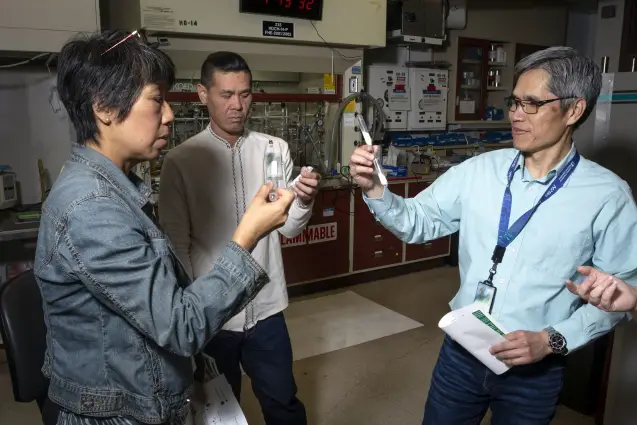LLNL’s Supplies Science Division (MSD) not too long ago hosted an open home showcasing its lab services and redesigned workspaces that help the division’s increasing analysis scope.
The occasion, led by Division Chief Manyalibo (Ibo) Matthews, featured excursions of up to date laboratory areas. At every tour cease, MSD scientists offered a short overview of the analysis that takes place of their labs, and invited guests to take a better take a look at their capabilities.
Between tour stops, LLNL Director Kim Budil chatted with attendees, reflecting on how MSD takes a multidisciplinary analysis method and helps each program at LLNL. “Customers of those workspaces embrace Lab researchers, collaborators and pupil interns, so we wished to make sure that the assets can successfully help a broad vary of mission wants,” Budil mentioned.
Throughout the day’s first tour, Budil and different VIP friends had been available for the official grand opening of certainly one of MSD’s latest assets — the Laser Induced compression of Grain scale with Excessive Throughput (LIGHT) Lab. The LIGHT Lab is house to a high-energy laser, able to firing a shot each minute and supporting speedy, cost-effective investigations of laser-shocked supplies. Tour presenter Paulius Grivickas defined that the laser was initially developed to help LLNL’s nuclear deterrence mission, and it’ll even be obtainable for different analysis functions.
The MSD group related to the LIGHT Lab is led by Jon Belof, who additionally leads undertaking DarkStar, an LLNL strategic initiative targeted on discovering new ideas that permit software of synthetic intelligence to manage shock wave and materials dynamics. As a current instance, DarkStar is finding out methods to mitigate materials jetting attributable to defects underneath shock loading by exploiting particularly tailor-made shock wave constructions throughout loading. DarkStar experiments performed on the Superior Photon Supply at Argonne Nationwide Lab have already improved understanding of shocked supplies underneath various situations, and use of the LIGHT Lab will enormously enhance throughput of those shock experiments.
At one other tour cease, MSD scientist Kaila Bertsch described analysis underneath manner within the new Gleeble Thermomechanical Simulator, which may apply masses at excessive temperatures to simulate industrial processing in addition to excessive setting functions, all at temperatures as much as 3,000° Celsius. Its capabilities allow researchers to watch the properties and traits of supplies in excessive situations, underneath large masses.
In keeping with Bertsch, the simulator’s capabilities have already helped entice new hires to LLNL. Actually, the chance to be a part of supplies science analysis is what finally introduced her to the Lab. She got here to LLNL as a result of she was enthusiastic about utilizing distinctive experimental assets and collaborating in analysis alternatives that aren’t usually obtainable elsewhere for early- and mid-career professionals.
Effectivity was a recurring theme on the tour, together with a cease on the Duralumin Actinide Synthesis Lab to see the place feedstock preparation for a lot of initiatives happens. One of many feedstocks produced on this lab led to a hydride/dehydride undertaking within the Larasium Lab, targeted on alloy improvement. In keeping with artificial chemist Bradley Childs, this functionality can flip 10 milligrams of uncooked supplies into 9 milligrams of latest supplies, whereas additionally recycling the waste for future use.
Down the corridor from the Larasium Lab, guests toured the Supplies Characterization Middle, which is able to quickly be increasing by a whole lot of sq. ft to deal with an array of capabilities targeted on actinide analysis and related diagnostics. This person facility contains a numerous assortment of fabric preparation and characterization capabilities, together with an X-ray diffraction suite, a targeted ion beam, electron microscopy laboratories, an ion accelerator and metallography/precision pattern fabrication labs.
Middle supervisor Jonathan Lee mentioned that the middle helps analysis throughout LLNL. “We prefer to suppose that we are able to work with the entire periodic desk, so we are able to help everybody who involves us on the lookout for assist,” Lee mentioned.
Each tour cease featured capabilities that profit present initiatives and are anticipated to play key roles in future analysis. Budil emphasised this end result, describing the Lab’s supplies science assets as “an instance of how we need to facilitate nice science in help of our mission, whereas creating environments that characterize how a lot LLNL values our employees.”
Standing subsequent to a wall that includes journal covers from greater than two dozen publications highlighting current MSD analysis, Matthews famous that the journal cowl show “highlights the division’s accomplishments and exhibits our satisfaction within the nice work achieved by our employees.” As well as, Matthews shared that within the final three years, the division has grown from 400 employees to roughly 530 employees as we speak, with extra people becoming a member of MSD every month.
–Amy Weldon, TID
